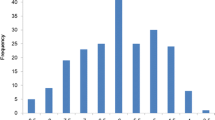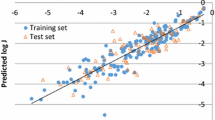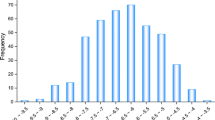Abstract
Purpose
Chemical penetration enhancers (CPEs) are important in transdermal drug delivery (TDDD) formulations because they assist drugs in moving across the stratum corneum. Hydrocortisone (0.1% hydrocortisone, propylene glycol), oestradiol (0.045 mg estradiol/0.015 mg levonorgestrel, propylene glycol), and testosterone (2% testosterone, propylene glycol) are some examples of marketing TDDD formulations. As the transdermal route for drug administration becomes a safer and more appealing alternative to hypodermic needles, the search for new CPEs and their development becomes more important. Thus, the current work was directed toward the rapid identification of potent CPEs through the development of robust machine learning (ML) classification models.
Methods
Two large penetration enhancer (PE) data sets reported to date such as hydrocortisone (139 PEs) and theophylline (101 PEs) were used to build classification models. In the present investigation, a combination of feature selection methods, i.e., Boruta and Recursive Feature Elimination (RFE), and machine learning (ML) algorithms such as support vector machine (SVM), random forest (RF), and artificial neural network (ANN) were employed to classify the potent and weak penetration enhancers of hydrocortisone and theophylline. The tenfold cross-validation and Y-randomization methods were used to evaluate the prediction performance of the developed models.
Results
Significant classification models were built for both data sets when the RFE method and RF algorithm were used. RF classifiers outperformed hydrocortisone and theophylline data sets with test set accuracy and Matthew’s correlation coefficient (MCC) greater than 0.78. Simultaneously, four important features required for the accurate classification of potent and weak PEs were identified, i.e., nHCsatu, minHCsatu, AATS4p, and GATS4e.
Conclusion
Our approach produced robust ML classification models that can be applied to prioritize PEs from large databases. Utilization of these ML models in virtual screening experiments could save time and effort in the identification of potential PEs.
Graphical Abstract










Similar content being viewed by others
Data Availability
Data made available upon request.
Abbreviations
- ML:
-
Machine learning
- RFE:
-
Recursive Feature Elimination
- RF:
-
Random forest
- PEs:
-
Penetration enhancers
- ER:
-
Enhancement RATIO
- SVM:
-
Support vector machine
- ANN:
-
Artificial neural network
- AUC:
-
Area under curve
- ROC:
-
Receiver operating characteristic curve
- SC:
-
Stratum corneum
- QSPR:
-
Quantitative structure–permeability relationship
- TDDD:
-
Transdermal drug delivery
References
Pailler-Mattei C, Bec S, Zahouani H. In vivo measurements of the elastic mechanical properties of human skin by indentation tests. Med Eng Phys. 2008;30(5):599–606.
Seki T, Morimoto K. Enhancing effects of medium chain aliphatic alcohols and esters on the permeation of 6-carboxyfluorescein and indomethacin through rat skin. Drug Deliv. 2003;10(4):289–93.
Williams A, Barry B. The enhancement index concept applied to terpene penetration enhancers for human skin and model lipophilic (oestradiol) and hydrophilic (5-fluorouracil) drugs. Int J Pharm. 1991;74(2–3):157–68.
Sinha V, Kaur MP. Permeation enhancers for transdermal drug delivery. Drug Dev Ind Pharm. 2000;26(11):1131–40.
Willams A, Barry B. Permeation enhancer. Adv Drug Deliv Rev. 2012;64:128–37.
Lundborg M, Wennberg CL, Narangifard A, et al. Predicting drug permeability through skin using molecular dynamics simulation. J Control Release. 2018;283:269–79.
Katz M, BJ P. Corticoid, vehicle, and skin interaction in percutaneous absorption. 1972.
Ghafourian T, Zandasrar P, Hamishekar H, et al. The effect of penetration enhancers on drug delivery through skin: a QSAR study. J Control Release. 2004;99(1):113–25.
Iyer M, Zheng T, Hopfinger AJ, et al. QSAR analyses of skin penetration enhancers. J Chem Inf Model. 2007;47(3):1130–49.
Kalhapure RS, Salunke CL, Akamanchi KG. QSAR model for chemical penetration enhancers containing long hydrocarbon chain. Chemom Intell Lab Syst. 2012;118:267–70.
Lim CW, Fujiwara S-I, Yamashita F, et al. Prediction of human skin permeability using a combination of molecular orbital calculations and artificial neural network. Biol Pharm Bull. 2002;25(3):361–366.
Potts RO, Guy RH. A predictive algorithm for skin permeability: the effects of molecular size and hydrogen bond activity. Pharm Res. 1995;12(11):1628–33.
Pugh W, Wong R, Falson F, et al. Discriminant analysis as a tool to identify compounds with potential as transdermal enhancers. J Pharm Pharmacol. 2005;57(11):1389–96.
Cronin MT, Schultz TW. Pitfalls in QSAR. J Mol Struct (Thoechem). 2003;622(1–2):39–51.
Buchwald P, Bodor N. A simple, predictive, structure-based skin permeability model. J Pharm Pharmacol. 2001;53(8):1087–98.
Barratt M. Quantitative structure-activity relationships for skin permeability. Toxicol In Vitro. 1995;9(1):27–37.
Abraham MH, Martins F, Mitchell RC. Algorithms for skin permeability using hydrogen bond descriptors: the problem of steroids. J Pharm Pharmacol. 1997;49(9):858–65.
Moss G, Shah A, Adams R, et al. The application of discriminant analysis and machine learning methods as tools to identify and classify compounds with potential as transdermal enhancers. Eur J Pharm Sci. 2012;45(1–2):116–27.
Welling SH, Clemmensen LK, Buckley ST, et al. In silico modelling of permeation enhancement potency in Caco-2 monolayers based on molecular descriptors and random forest. Eur J Pharm Biopharm. 2015;94:152–9.
Simon L, Abdelmalek B. Design of skin penetration enhancers using replacement methods for the selection of the molecular descriptors. Pharmaceutics. 2012;4(3):343–53.
Tenjarla SN, Kasina R, Puranajoti P, et al. Synthesis and evaluation of N-acetylprolinate esters—novel skin penetration enhancers. Int J Pharm. 1999;192(2):147–58.
Kim N, El-Khalili M, Henary M, et al. Percutaneous penetration enhancement activity of aromatic S, S-dimethyliminosulfuranes. Int J Pharm. 1999;187(2):219–29.
Song Y, Xiao C, Mendelsohn R, et al. Investigation of iminosulfuranes as novel transdermal penetration enhancers: enhancement activity and cytotoxicity. Pharm Res. 2005;22(11):1918–25.
Fincher TK, Yoo SD, Player MR, et al. In vitro evaluation of a series of N-dodecanoyl-L-amino acid methyl esters as dermal penetration enhancers. J Pharm Sci. 1996;85(9):920–3.
Fuhrman L Jr, Michniak B, Behl C, et al. Effect of novel penetration enhancers on the transdermal delivery of hydrocortisone: an in vitro species comparison. J Control Release. 1997;45(2):199–206.
Michniak B, Player M, Godwin D, et al. Investigation of enhancer structure activity relationships in congeners of 2-(1-nonyl)-1, 3-dioxolane. Drug Deliv. 1995;2(2):117–22.
Michniak B, Player M, Godwin D, et al. In vitro evaluation of azone analogs as dermal penetration enhancers: V. Miscellaneous compounds. Int J Pharm. 1998;161(2):169–78.
El-Kattan AF, Asbill CS, Michniak BB. The effect of terpene enhancer lipophilicity on the percutaneous permeation of hydrocortisone formulated in HPMC gel systems. Int J Pharm. 2000;198(2):179–89.
Godwin DA, Player MR, Sowell JW, et al. Synthesis and investigation of urea compounds as transdermal penetration enhancers. Int J Pharm. 1998;167(1–2):165–75.
Vávrová K, Hrabalek A, Doležal P, et al. L-Serine and glycine based ceramide analogues as transdermal permeation enhancers: polar head size and hydrogen bonding. Bioorg Med Chem Lett. 2003;13(14):2351–3.
Kopečná M, Macháček M, Nováčková A, et al. Esters of terpene alcohols as highly potent, reversible, and low toxic skin penetration enhancers. Sci Rep. 2019;9(1):1–12.
Chen Y, Quan P, Liu X, et al. Novel chemical permeation enhancers for transdermal drug delivery. Asian J Pharm Sci. 2014;9(2):51–64.
Yap CW. PaDEL-descriptor: an open source software to calculate molecular descriptors and fingerprints. J Comput Chem. 2011;32(7):1466–74.
Kuhn M. caret: Classification and Regression Training. Astrophysics Source Code Library, ascl: 2015. 1505.003.
Xue Y, Yap CW, Sun LZ, et al. Prediction of P-glycoprotein substrates by a support vector machine approach. J Chem Inf Comput Sci. 2004;44(4):1497–505.
Xue Y, Li H, Ung C, et al. Classification of a diverse set of Tetrahymena pyriformis toxicity chemical compounds from molecular descriptors by statistical learning methods. Chem Res Toxicol. 2006;19(8):1030–9.
Lin H, Han L, Yap C, et al. Prediction of factor Xa inhibitors by machine learning methods. J Mol Graph Model. 2007;26(2):505–18.
Kursa MB, Rudnicki WR. Feature selection with the Boruta package. J Stat Softw. 2010;36(11):1–13.
Boser BE, Guyon IM, Vapnik VN, editors. A training algorithm for optimal margin classifiers. Proceedings of the 5th Annual ACM Workshop on Computational Learning Theory. 1992.
Tong S, Chang E, editors. Support vector machine active learning for image retrieval. Proceedings of the ninth ACM international conference on Multimedia; 2001.
Yuan L-F, Ding C, Guo S-H, et al. Prediction of the types of ion channel-targeted conotoxins based on radial basis function network. Toxicol In Vitro. 2013;27(2):852–6.
Yao X, Panaye A, Doucet J, et al. Comparative classification study of toxicity mechanisms using support vector machines and radial basis function neural networks. Anal Chim Acta. 2005;535(1–2):259–73.
Fernandez-Lozano C, Cuinas RF, Seoane JA, et al. Classification of signaling proteins based on molecular star graph descriptors using Machine Learning models. J Theor Biol. 2015;384:50–8.
Breiman L. Random forests. Mach Learn. 2001;45(1):5–32.
Segal MR. Machine learning benchmarks and random forest regression. 2004.
Karlik B, Olgac AV. Performance analysis of various activation functions in generalized MLP architectures of neural networks. International Journal of Artificial Intelligence and Expert Systems. 2011;1(4):111–22.
Riedmiller M, Braun H, editors. A direct adaptive method for faster backpropagation learning: The RPROP algorithm. IEEE international conference on neural networks; 1993: IEEE.
Baldi P, Brunak S, Chauvin Y, et al. Assessing the accuracy of prediction algorithms for classification: an overview. Bioinformatics. 2000;16(5):412–24.
Funding
This work was financially supported by the Department of Biotechnology (DBT), New Delhi (BT/ PR39876/BTIS/137/7/2021).
Author information
Authors and Affiliations
Corresponding author
Ethics declarations
Ethical Approval
No animals were harmed in this study.
Competing Interests
The authors declare no competing interests.
Additional information
Publisher's Note
Springer Nature remains neutral with regard to jurisdictional claims in published maps and institutional affiliations.
Supplementary Information
Below is the link to the electronic supplementary material.
Rights and permissions
Springer Nature or its licensor (e.g. a society or other partner) holds exclusive rights to this article under a publishing agreement with the author(s) or other rightsholder(s); author self-archiving of the accepted manuscript version of this article is solely governed by the terms of such publishing agreement and applicable law.
About this article
Cite this article
Raju, B., Verma, N., Narendra, G. et al. Classification of Potent and Weak Penetration Enhancers Using Multiple Feature Selection Methods and Machine Learning Models. J Pharm Innov 18, 1778–1797 (2023). https://doi.org/10.1007/s12247-023-09757-y
Accepted:
Published:
Issue Date:
DOI: https://doi.org/10.1007/s12247-023-09757-y




